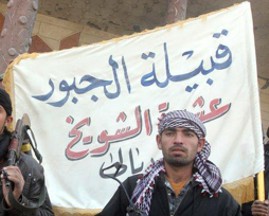
image located by William Garrison, 24 April 2016

Last modified: 2020-07-31 by ian macdonald
Keywords: sunni awakening movement | iraq | sahwa |
Links: FOTW homepage |
search |
disclaimer and copyright |
write us |
mirrors

image located by William Garrison, 24 April 2016
I have no idea who/what/where. Only that the E- in the middle line suggests this is Persian script rather than Arabic. Hence, maybe Iranian group (in Syria?). (source)
William Garrison, 24 April 2016
At the Assyrian International News Agency website, this photo (credit line: Ahmad Al-rubaye/AFP/Getty Images) is legended thusly: "Iraqi Sunni fighters from the Jubur tribe hold a flag in front of a house damaged during clashes with the Islamic State in the village of Sharween, northeast of Baghdad, on Jan. 27. The U.S. is trying to get more Sunni tribes to drop their support for ISIS and fight with the Iraqi government and the Americans". (actual photo)
The writing on the flag is in the Arabic script but, as William points out, it doesn't seem the usual Arabic language orthography. It must be then another of the many languages that are usually spelt with Arabic letters, Persian being much less likely than, say, (soranî ) Kurdish. Granted that the Jubur tribe is Arabic-speaking, but the photo caption might be inaccurate.
I read "قبٻُلة الٰجوٜر" (with two dots side-by-side under the funky beh and not really a damma over it) on the upper line (blue letters) and "السٛو.." on the second line (red letters), but neither means anything to me.
António Martins-Tuválkin, 25 April 2015
Other images of this flag can be seen here: (image) (source) published on March 17, 2015, and at (image) (source), published on March 29, 2016. It also can be found at (image) (source), published on March 28, 2016), and here (image) (source). This last article claims to be published on February 3, 2015: thus the image of the flag is earlier than 2016. This article contains the picture's caption which reads: "Iraqi Sunni fighters from the Jubur tribe hold a flag in front of a house damaged during clashes with the Islamic State in the village of Sharween, northeast of Baghdad, on Jan. 27. The U.S. is trying to get more Sunni tribes to drop their support for ISIS and fight with the Iraqi government and the Americans. Ahmad Al-rubaye/AFP/Getty Images" (this seems to be the original source of the image, since it is the oldest article showing it).
Indeed, Sunni Awakening movement (حركة الصحوة
السنية / Harakat al-Sahwah al-Sunnīyah), also known as Sons of Iraq (أبناء
العراق / Abnāʼ al-ʻIrāq), also known as Anbar's Salvation (
إنقاذ الأنب / Inqādh al-Anbār), the National Council for the Salvation of Iraq (المجلسالوطني
لإنقاذ العراق / -al-Majlis
al-Wa anī li-Inqādh al-Irāq), the Sunni Salvation Movement (
حركة الإنقاذ السني / Harakat al-Inqādh al-Sunnī), the National Council for the Awakening of Iraq (المجلس
الوطني لصحوة العراق /
al-Majlis al-Watanī li-Sahwat al-'Irāq) were coalitions between tribal Sheikhs in a particular province in Iraq as well as former Iraqi military officers that united to maintain security in their
communities. They were initially sponsored by the US military. The movement started among Sunni tribes in Anbar Province in 2005 to become an ad hoc armed force across the country in less than a year. The Sons of Iraq were virtually nonexistent by 2013 due to former Iraqi Prime Minister Nouri al-Maliki's unwillingness to integrate them (fully) into the security services. It was first established and known as an anti-AQI vigilante group known as Thwar-al-Anbar (the Anbar Revolutionaries) (TAA) and evolved into Sahwah al-Anbar (SAA)
Awakening movements in Iraq are also referred to as:
- "Mercenaries" (labeled as such by a Prime Minister Maliki's aide; also dubbed as such by al-Qa'eda)
- "Concerned Local Citizens" (CLC)
- "Sons of Iraq" (SOIZ) - labeled thus by the U.S. Military/Government of Iraq
- "Very Worried Iraqis" (VWI) - labeled thus by the U.S. Military/Government of Iraq
- "Critical Infrastructure Security" (CIS) - labeled thus by the U.S. Military/Government of Iraq
- "Abna Al-Iraq" (AAI) - labeled thus by the U.S. Military/Government of Iraq
- "Sahwa" Militia
- "Former Sunni insurgents" (CFR) (labeled as such by Senior Fellow Steven Simon)
The main active tribes (and subtribes whenever the case) groups were:
- Albu Risha
- Al-jaghayfa
- Al-jabbour (جبور / Jebour, Jibour, Jubour, Jabur, Jaburi, Jebouri, and Jabara - sometimes spelled as Jubbour and Al-jubour) (source)
- Shammar (شمّر / Šammar) (source)
- Dulaim Confederation (لدلي /also known as Dulaim, Dulaimi, Al-Duliam, Dulaym or Albu Alwan, Al-bu Fahd and the Al-bu
Assaf sub tribes. (source)
- Albu nimr (source)
- Albu isa (also known as Al-bu Issa)
- Albu dhiyab (also known as Al-bu Dhiyab)
- Albu ali (also known as Al-bu Ali)
- Albu fraj
Sources: Sons of Iraq and
Anbar Salvation Council
The above mentioned tribes are part of the Arab tribes in Iraq and the Coalition of Shiite militias to fight Isis.
In conclusion, the above reported flag is the flag of Sunni Awakening
Movement (حركة الصحوة السنية / Harakat al-Inqādh al-Sunnī) known by its various names and usually shortened to Sahwa. When looking for further information on the Jubur tribe I came across this particular article "Unusual Alliance Provides Hope, where this (image) is found, and below the Iraqi flag, one can see a Shiite prophet in the shredded flag near the fly, pretty much like
UFE 14-64.
Esteban Rivera, 18 May 2015